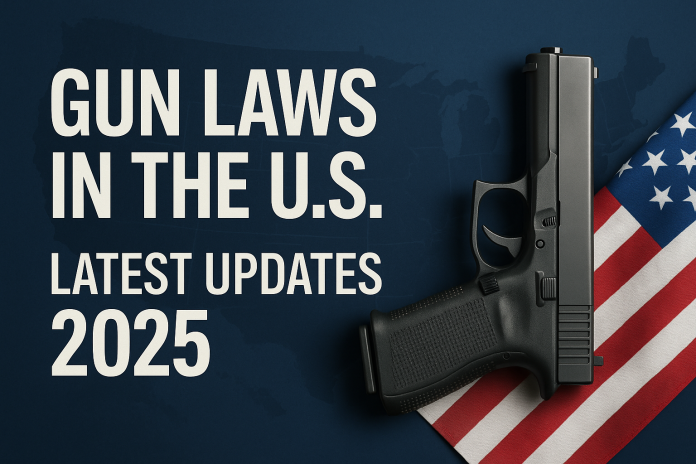Gun laws in the United States continue to evolve rapidly, especially through 2024 and into 2025. With growing public debate, legislative efforts, and major court rulings, the environment for firearm ownership and regulation is more complex than ever. This article breaks down the newest federal changes, major state updates, important judicial decisions, and what these developments mean for gun owners, dealers, policymakers, and communities.
1. Federal Updates in 2025
1.1 Federal Legal Framework
The federal foundation remains the Gun Control Act (GCA), which governs firearm sales, interstate transfers, licensing requirements, and background checks. The Bipartisan Safer Communities Act also continues influencing background-check enhancements and anti-trafficking provisions.
As of 2025, there is still no federal ban on:
-
Semi-automatic assault-style rifles
-
Large-capacity magazines
-
.50 caliber rifles
-
Most handgun models
1.2 New Federal Regulatory Changes (2025)
A number of new federal regulatory actions and guidelines came into effect:
• New Sentencing Guidelines (Effective Nov 2025)
The U.S. Sentencing Commission approved a “Firearms Amendment” updating federal sentencing rules for gun-related crimes. These changes increase penalties for illegal trafficking, straw-purchasing, and possession by prohibited individuals.
• Updated ATF Guidance for Dealers
The ATF issued updated nationwide guidance in 2025, including:
-
New compliance instructions for Federal Firearm Licensees (FFLs)
-
Revised background-check procedures
-
Enhanced inspection requirements
-
Updated rules on identifying “frames and receivers”
• Proposed Rule for Restoration of Firearm Rights
In mid-2025, the Department of Justice proposed a rule allowing individuals prohibited from owning firearms to apply for rights restoration — subject to strict review by the Attorney General.
1.3 Federal Bills to Watch in 2025
One of the most discussed bills is the Constitutional Concealed Carry Reciprocity Act, which would require every state to honor concealed carry permits from all other states. As of now, this bill is still under review and has not become law.
2. State-Level Gun Law Changes in 2025
State updates in 2025 show a clear division: some states are tightening restrictions, while others expand gun rights.
2.1 States Strengthening Gun Safety Laws
Several states passed major gun safety reforms this year, including:
• Colorado
Introduced one of the strictest new regulations on semi-automatic firearms, closing loopholes and restricting certain high-capacity devices. Also enacted laws preventing armed intimidation near polling stations.
• Illinois – Safe Gun Storage Act (2025)
Illinois passed a statewide “Safe Storage” law requiring all firearm owners to:
-
Secure guns with locks or safes
-
Prevent access by minors or unauthorized persons
-
Face penalties for negligent storage
• Oregon – Bump Stock and Public Building Restrictions (2025)
Oregon banned bump stocks and authorized local governments to block concealed weapons inside public buildings — provided clear signage is posted.
2.2 States Expanding Gun Rights in 2025
Some states moved in the opposite direction:
• Texas
Passed legislation preventing cities and counties from enforcing “red flag” laws and strengthened statewide protections for concealed carry.
• Other Pro-Gun States
A number of states expanded:
-
Permitless carry
-
Protections for gun stores during emergencies
-
Limitations on local gun restrictions
This ongoing split between states continues to widen the national policy divide.
3. Major Court Decisions in 2025
3.1 Supreme Court Rulings on Ghost Guns (2025)
In a landmark decision, the Supreme Court upheld federal regulation of “ghost gun kits” — unassembled firearm parts that previously lacked serial numbers. The ruling confirmed that the ATF can classify these kits as regulated firearms.
This decision dramatically reduces the availability of untraceable guns.
3.2 Federal vs. State Conflicts
Some states that refuse to implement red-flag laws or restrict local gun enforcement have created tension with federal agencies, especially where firearm trafficking, background checks, or concealed-carry rules differ sharply.
3.3 Sentencing Enforcement Shifts
With the new 2025 sentencing guidelines, federal prosecutors are expected to focus more heavily on:
-
Trafficking cases
-
Straw purchases
-
Border-state gun smuggling
-
Possession by prohibited persons
4. What These Changes Mean for Gun Owners & Dealers
4.1 For Gun Owners
-
Safe-storage laws are now expanding and vary state-to-state
-
Some accessories (bump stocks, ghost-gun kits) may now be banned depending on your state
-
Traveling with firearms requires extra caution due to varying concealed-carry rules
-
Background-check procedures may be stricter depending on location
4.2 For Firearm Dealers (FFLs)
-
New ATF inspection standards mean stricter compliance
-
Updated record-keeping rules require meticulous accuracy
-
Selling parts kits or accessories now carries higher legal risk
-
Violations may result in immediate license revocation
4.3 For Policymakers & Advocacy Groups
-
States continue to serve as real-time “testing grounds” for new gun policies
-
Expect more focus on safe-storage, ammunition restrictions, and community safety programs
-
Continued legal battles over red-flag laws and permitless carry are likely through 2026
5. Outlook for Late 2025 and 2026
Emerging Trends:
-
National concealed-carry reciprocity debates may intensify
-
More states expected to adopt safe-storage laws
-
Regulation of 3D-printed guns will become a major issue
-
Accessory-based restrictions (bump stocks, conversion kits) will likely expand
-
Federal enforcement may shift toward trafficking prevention and interstate sales
-
Ghost-gun regulation will remain heavily litigated
Conclusion
Gun law changes in 2025 reflect a nation moving in two opposite directions. While some states strengthen firearm safety and restrict certain weapons or accessories, others expand gun rights and challenge federal involvement. The legal landscape is shifting rapidly, making it essential for gun owners, dealers, and policymakers to stay updated. As more rules take effect in late 2025 and early 2026, understanding these developments is critical for compliance and safety nationwide.



